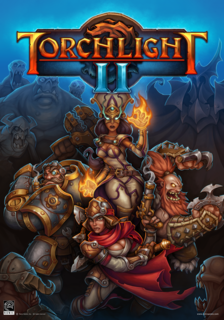You've traveled this long and lonely road before, but never in such smoothness and polish.
Yet, Torchlight II managed to be a success without innovating, being original or by messing with the action role-playing game models. Torchlight is quite simply the result of fine tuning and polishing the formula that made the Diablo series, Titan Quest, Sacred, Dungeon Siege and other like-minded franchises what they were.
Torchlight II, in fact, has so much material in terms of predecessors to draw on that they had the answer key right in front of them as if lent by an older frat buddy. Many feel that Diablo II found the perfect formula for the point-and-click action game, and Runic perhaps did as well. rnMuch of what makes Torchlight II so appealing is exactly what other point-and-click RPGs decided to depart from. The skill system and the ability to play off-line make Torchlight II feel more like the successor to Diablo II that Diablo III is. Still, Torchlight II's desire to stick with the current's flow and try its best to perfect existing formulas make the game feel uncomfortably familiar.
The game world that Torchlight II is set in feels much like that of many other point-and-click RPGs. You travel around, kill monsters and bosses, find tiered loot and sell it off at the designated town associated with the particular story arc you are playing through. The beauty and polish of Torchlight II's graphics, the plentiful loot and the frequency with which one fights bosses make Torchlight stand apart from the rote quality of its genera brethren, but it is still merely an improvement on an old formula. Occasional side quests and bonus dungeons do little to make the adventure seem more original.
Torchlight should be lauded for the art quality, which sort of mimics the impressionism movement of the late 1800s. The world is vibrant, rich with life and one never gets tired of looking at each stage. Great music accompanies it, giving the player a good reason to spend more time inside Torchlight's world than might ordinarily be warranted. Perhaps the crowning achievement of the game is the silky smoothness of the engine despite pulling off the looks and the substance. This is all the more remarkable when considering its competitor's notorious rubber-banding and server issues, and Torchlight II's incredible price of $20. It is the same engine as the original Torchlight, but the sequel looks much better.
Torchlight II is a tough game on the normal difficulty, but not so much so that it becomes frustrating. Set to "Hard", the game requires a lot of thinking about armor and stats as the difficulty spikes. The story itself makes little sense, unless you remember the previous game's story, which still only adds a bit of coherence. The game does not feel profound in its story telling, but this is less important in a game primarily designed to make killing stuff over and over again enjoyable.
After all is said and done, when you've finally finished the main quest and you look back on your trip, a curious feeling of nostalgia will creep up on you and remind you that you've done all this before. It may be the most polished in a long road of point-and-click RPGs, but the trip and the destination are the same as they've always been. The formula isn't so tired that a great game like Torchlight II goes unappreciated, but one has to think that the end of the road can't be too far ahead.

